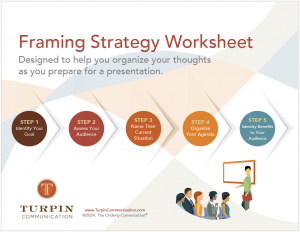
- Dale Ludwig Meetings, Presentations
Maximize the Benefits and Reduce the Snags of Team Projects and Presentations
In the first of a two-part series on team collaboration, we discuss the importance of having a framing strategy.
When you were in school, you probably heard the words “group project” and groaned internally. You anticipated days or weeks of miscommunication, differing opinions about direction and effort, unmet internal deadlines, and often an all-nighter for the one or two team members who took the project seriously. Then you went into your first grownup job only to discover that some portion of your work, maybe most of it, would be done in the context of a team. And while those expectations and behaviors from high school may have changed some, you probably didn’t get much training or direction on how to make a team really thrive. We’re going to give you some help with that by talking about our approach to team collaboration, both what we teach our clients and what we practice internally. All of this is designed to work whether you’re in a team of two or twenty.

Successful team collaboration begins with framing. If you’ve taken one of our courses or been a devoted reader of this blog, our Framing Strategy may look familiar, but now we’re going to adapt it to the team process.
Download the Framing Strategy Worksheet here.
Framing Gets Everyone on the Same Page
We talk about framing as a way to begin and end a meeting or presentation. A frame helps both you and your audience understand the context, purpose, benefits, and contents of the conversation. When you’re starting a collaborative project, you should frame both the whole project and each individual meeting in order to maximize efficiency and ensure that everyone agrees on the goals and direction of the project. In fact, a kickoff meeting that uses the four elements of the framing strategy as its agenda is a great idea. It will ensure that everyone is equipped with the same information. We’ll look at both uses of the frame: the overall project and individual meetings.
The current situation or context
- At the project level: The current situation includes the circumstances that led up to the project and why it was assigned to this team. You might be surprised to discover how different people’s understanding of the assignment is. If you articulate the current situation up front, there’s time to ask for clarification before the real work begins and to ensure that all the work is serving the correct goal.
- At the individual meeting level: The current situation should reflect what has been accomplished up to now and where you are in the project. It should also include any recent or ongoing challenges or accomplishments that will be relevant to this meeting. Talking about the current situation establishes context and focus for each meeting.
The goal
- Of the project: What do you need to accomplish by the project deadline? What does success look like? This is far more than just a checklist of tasks. Here’s where broad strategic thinking helps. Use the phrases “so that” or “in order to” to help you articulate a strategic goal. For example, “The goal of this project is to create a sales presentation to deliver to ClientCo on February 8” just reflects the what of the task. It’s a to-do list, not a goal. Instead, be sure you include the why: “The goal of this project is to create a sales presentation to deliver to ClientCo on August 18 in order to offer a more efficient product bundle that will decrease their costs and increase our share of their overall procurement dollars by at least 12 percent.” This option gives the team a much more specific brief to work toward and will direct in important ways how the project is approached and completed.
- Of each meeting: When teams meet frequently on the same overall project, meetings can devolve into shapeless conversations about whatever is on individuals’ minds. This approach may answer some random tactical questions, but it won’t move the whole team forward in a meaningful way. Setting a clear goal for the time the team spends together—and making sure everyone understands the “so that” or “in order to” of the meeting—will increase efficiency and focus.
The benefit(s)
Even for a regular meeting, sometimes the goal and the benefit are pretty much the same, but it’s worthwhile to think about benefits separately, at least at the start. You may be surprised at what you learn and how it shapes the project.
- Benefits of the project: This may seem like an odd thing to focus on. The benefits to individual team members are ultimately that they keep their jobs, get raises, and feel a sense of accomplishment. But what else is going on? Are there skills people want to apply or expand? Would it be useful to focus on the benefits to the business as a whole? Doing so might remind people of the importance of the project beyond their contribution to it.
- Benefits of individual meetings: Especially if someone has hit a wall in their individual work, articulating the benefit of a particular meeting can be motivating and clarifying. For example, here’s a benefit and goal that show different sides of the same idea: “The goal of today’s meeting is to narrow down to three color palettes for the prototypes. The benefit of getting that done today is that Erin can place an order for materials and can start building the prototypes this week.”
The agenda
- For the project: The agenda for a project itself is really the to-do list. However, if you think about it the same way you would the agenda for a presentation or meeting, you accomplish several things: you put the steps in the order they will be most efficient and logical, you think about what sub-tasks go under which large list items, and most importantly, you outline the story arc of the project, working toward the goal you’ve already defined. Once the to-do list is laid out, each individual’s responsibilities can be assigned.
- For individual meetings: It’s really tempting to skip an agenda for a regularly occurring meeting. You might assume that everyone knows the priorities of this meeting and how it will go. But establishing an agenda, and ideally distributing it in advance, signals what will be talked about and, equally important, what won’t. This helps the team’s work feel efficient and focused, maximizing everyone’s time and letting the real work get done.
One final thought on framing. Often, the conclusion or wrap-up gets short shrift in meetings or presentations, particularly if there are agenda items to finish and you’re fighting against the clock. In a collaborative setting, that wrap-up is especially important. People should leave the room feeling as though they know a) what has been accomplished, b) what, if anything, needs to be carried over for further discussion because it wasn’t completed, and c) what everyone’s assignments and roles are for the next phase of the project. This final touch-base is vital to alignment and momentum. Extremely functional teams have this captured in written minutes.
All of this is to say that, unlike in high school, professional team collaboration requires planning, analysis, and lots of conversation to be as successful and as painless as possible. Frame up the project, frame each meeting, and you’re well on your way.
Click this link to read Part 2 of Team Collaboration in the Workplace.

